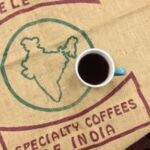SHOULD THE WORLD LOOK TO INDIA FOR COFFEE’S FUTURE?
Throughout the world, coffee growers are struggling with the dual challenges of climate change and low coffee prices. As the coffee industry looks for more environmentally and economically sustainable ways to cultivate beans, we note that so many of the proposed changes are measures already in place at Indian coffee farms.
SHADE GROWN AND BIRD FRIENDLY
Growing coffee in high-diversity shade remains the most environmentally sustainable way to cultivate coffee. Surprisingly, India is just one of the few countries that continue to grow the majority of their coffee using such traditional techniques. Nearly every other coffee origin grows coffee in sun or, at best, low-density, low-diversity shade.
The shade used in Indian coffee plantations falls into two categories: an upper, permanent canopy and a lower, temporary canopy. Upper canopy shade consists primarily of Silver Oak and native jungle trees that may tower 100 feet or more above ground level. The lower canopy is traditionally populated by Dadap (Eryhtrenia Lithosperma) trees, which managers can easily prune to regulate the amount of sunshine and rain reaching the coffee plants.
The increasing variety of overhead shade trees provides a sanctuary for birds and other wildlife. The decomposed organic matter from animal waste and falling leaves enriches the soil, conserves moisture, and reduces the need for chemical fertilizers. Shade trees also control the growth of weeds and reduce the incidence of insects, pests, and leaf disease. This, in turn, reduces the need for chemical pesticides and herbicides.

Coffee is grown under shade trees that carry pepper vines.
POLYCULTURE- NOT COFFEE MONOCULTURE
Most Indian coffee plantations grow fruits and spices amidst their coffees. Producers planted these crops long ago after concluding that coffee alone could not support the land economically, especially given the volatility of global coffee prices. Now it is common to find oranges, tangerines, cinnamon, cardamom, nutmeg, cloves, and pepper vines growing alongside an estate’s coffee plants. The end result is greater economic sustainability due to a more diverse collection of products.
The coffees receive a unique benefit as well, as they often acquire some of the taste and aroma of the fruits and spices planted nearby. The result is a character in the cup that distinguishes Indian beans from those grown in other origins.
HAND PICKED AND SUN DRIED
All coffee in India is handpicked without the use of machinery so that only the fully ripe beans are harvested. Under-ripe beans are allowed to remain on the plants and ripen further. This selective picking- with multiple rounds of picking- ensures that India’s beans are at the peak of flavor when picked.
Indian coffee is also sun dried on patios lined with brick, stones, or concrete. Many estates will also use raised beds for the initial stages. Although this process takes much longer than mechanical drying, growers know that the slower drying period actually enhances the flavor in the beans.
WATER HARVESTING
Coffee-growing regions in India receive between 60 and 120 inches of rain each year. Some regions receive all their precipitation during one of the two monsoon seasons, while others split their rainfall between the two monsoons. With that much rain each year, it is perhaps difficult to imagine that a coffee plant’s ability to withstand drought is an important criterion for selecting a particular hybrid for planting.
Rains during the monsoons are so heavy that much of the water simply runs off the steep slopes of coffee plantations without soaking deep into the soil. Thus, it’s not uncommon to see coffee plants suffering the effects of drought barely three months after the end of the monsoon season.
Many owners have begun to harvest the water falling on their estates (in large pools or tanks) and are storing it for use during the dry months. They use some of the water for pulping, fermenting, and washing their coffees during processing, but also for irrigating their coffee plants during the driest of Indian summers.
Learn more about Josuma Select green coffee from India>>>

